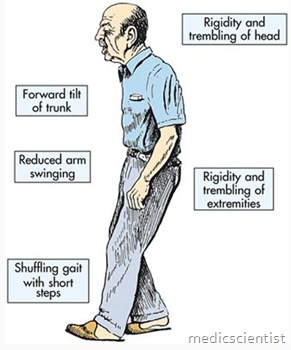Article Contents ::
- 1 HISTORICAL REVIEW of Kampavata (Parkinson’s disease)
- 2 Kampavata (Parkinson’s disease) According to Different SAMHITA —
- 3 VEDIC PERIOD:-
- 4 CARAKA SAMHITA :-
- 5 SUSRUTA SAMHITA:-
- 6 MADHAVA NIDANAM:-
- 7 HARITA SAMHITA:-
- 8 ASTANGA SANGRAHA AND ASTANGA HRDAYA :-
- 9 SARNGADHARA SAMHITA :-
- 10 BHAISHAJYA RATNAVALI:-
- 11 The major factors involved in Samprapti of Kampavata are as follows.
HISTORICAL REVIEW of Kampavata (Parkinson’s disease)
- Kampavata (Parkinson’s disease) is a slowly progressive disease of late adult life and is one of the most prevalent neurological disorder. In Caraka Samhita ‘Vepathu’ has been described as one of eighty type of Nanatmaja disorders of Vata and Kampa has been mentioned one of the Vikera of Vata. Because of its crippling nature and non-availability of curative treatment, this disease has remained a great problem in the aging society. Though in modern medical science a lot of research work has been done still no definite radical therapy is available for this disease.
For understanding of the disease here an attempt is being made to trace the history of Kampavata (Parkinson’s disease) according to Ayurvedic and modern sciences.
Kampavata (Parkinson’s disease) According to Different SAMHITA —
VEDIC PERIOD:-
- Vedas are known as the root of all available knowledge where one can find the description regarding the diseases and their treatment also. Though detailed description of Kampavata is not found. In Rigveda Vepathu / Kampa (1:8:11, 5:36:3) has beenmentioned. It occurs due to Indra Dusti, and in Atharvaveda some description of Vepathu is available. While in Atharvaveda the drugs effective for the treatment of Vayu have also been described. For example Pippali is useful for Kshipta. (6:101:3)
CARAKA SAMHITA :-
- Caraka has also mentioned the tremors (Kampa) occurring in different organs like head, (Ca. Si- 5/57; Ca.Si- 9/86,87) In Sutrasthana- 17/14 Shirokampa has been considered as one of most important disease of Shira (head ) and Nasya has been advocated for its treatment. It has been further specified that Tarpana Nasya, and in Stambha Virechana Nasya should be given.
- In Ayurvedic texts various synonyms of Kampa is found one of them is Vepathu in Caraka Samhita Vepathu has been described as one of the eighty types of Nanatmaja Vyadhi of Vata ( Ca.Su-20/9). The main symptoms of the disease viz, Kampa and Stambha ,are found in some pathological condition of Vata Vyadhi Caraka mentions that the condition where Pitta is decreased and Kapha and Vata are increased the increased Kapha and Vata together produce symptom like Kampa, Stambha etc (Ca.Su-17/65,66). The increased Vata affecting the Marma (vital parts) causes Vepana (ca. Su. 17/61). This concept provides a base for understanding the pathology of tremor relating to brain (Marma). Caraka includes Stambha in the vitiated symptoms of Vata (Ca.Su- 20 & Su-28/21) mentions that Stambha is a disorder of Snayu.
SUSRUTA SAMHITA:-
- Susruta mentions in Ni-1/27 that the aggravated Vayu in Snayu, produces numbness, Kampa and when incarcerated in Sira (veins) it produces stiffening and painful condition. It has been mentioned that poisoning due to Kalakuta and Mustaka manifests as Gatrastambha (rigidity) and Vepathu i.e. tremors (Su.K-2/12,15). Vepathu is also a long-term complication of Dushivisha (Su. K-2) Diminished blinking slurred speech and tremor are complication of Ardita (Su.Ni- 1/73).
MADHAVA NIDANAM:-
- Vepathu is the condition caused by Vata in which all the parts of the body including the head are having the tremors. This includes towards the clinical picture of Kampavata.
HARITA SAMHITA:-
- Its author explains that Meda-Avritta-Vvyana Vayu produces symptoms like Kampa. It has been further stated that Kampa and Nidranasha may occur due to provocation of Samana Vayu, in the complications of Ardita, Kampa has also been included.
ASTANGA SANGRAHA AND ASTANGA HRDAYA :-
- The Kampa has been mentioned as one of the symptoms of Vata Prakopa (Ah.Su. -12) and has also been accepted as one of the symptoms of Sarvanga Vata (A.H.Ni- 15/15).Astanga Sangraha and Astanga Hrdaya both explained that Stambha occurs in the condition of Mamsagata Vata Medogata Vata and Majjagata (A.S.Ni- 15/11,15; A.H.Ni-15/11,15) Astanga Sangraha mentions Kayasya Vepathu as a symptom of ageing (A.S.Su. 8/22), and Kampa is noted in Raktakshaya, Pittakshaya and Kaphakshaya condition (A.S.Su-. 17/5)
SARNGADHARA SAMHITA :-
- Kampa has also been included under the Nanatmaja disorder of Vata (PV- 7/12) Masadi Nasya it has been mention those relieves Paksaghata (Hemiplegia) associated with Kampa (tremor), Ardita (facial paralysis) and Manyastambha (Ut- 8/36,37)
BHAISHAJYA RATNAVALI:-
- The remedies like Nakul Taila, Nakuladya Ghrita, Sarvanga Kampari Rasa etc have been recommended for the treatment of Kampavata.
The major factors involved in Samprapti of Kampavata are as follows.
- Dosa : Vata – All five types especially Prana,
- Vyana, Udana,
- Pitta – Sadhaka
- Kapha – Tarpaka
- Dushya : Dhatu – Rasa, Majja, Sukra, Mamsa,
- Updhatu _ Snayu, Ojas
- Mala _ Purisha, Vitsneha
- Srotas : – Rasa, Sukravaha, Majjavaha,
- Mamsavaha
- Type of srotodushti – Sanga.
- Agni : – Jatharagni
- Marga : – Madhyama
- Site : – Of production – Pakvashaya, Shirastha
- Majja
- manifestation – Sarvanga.


